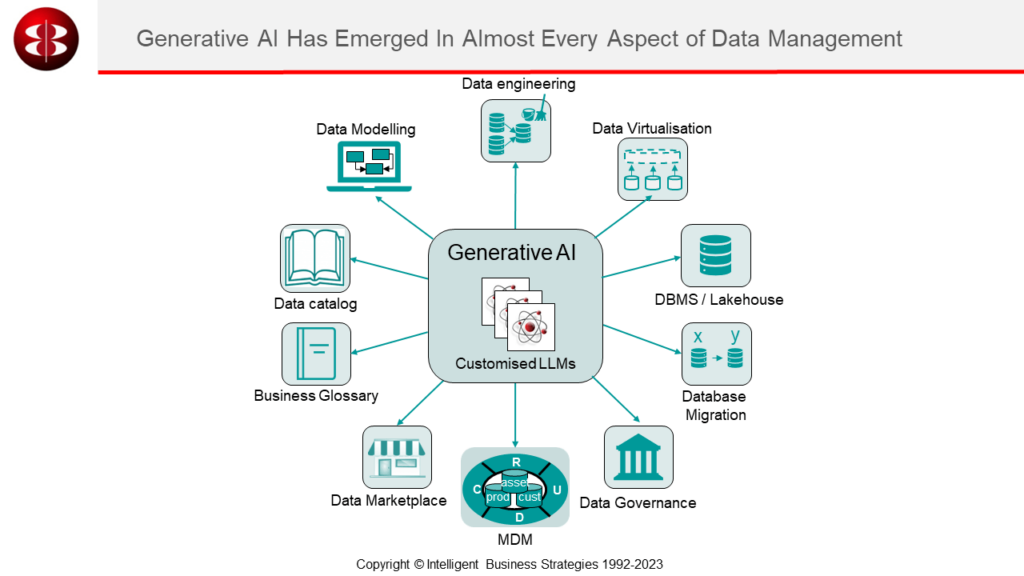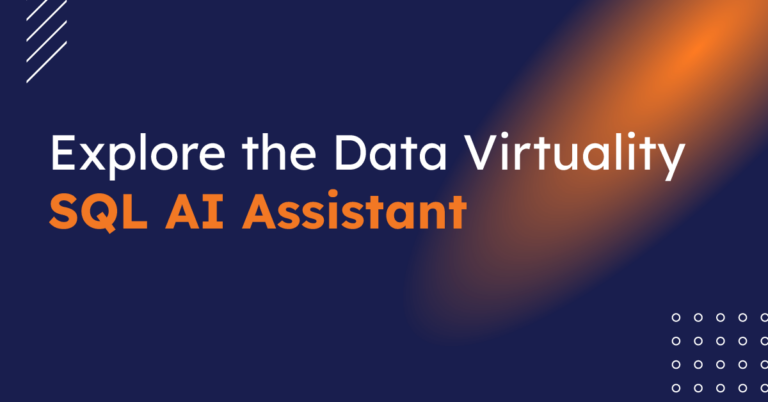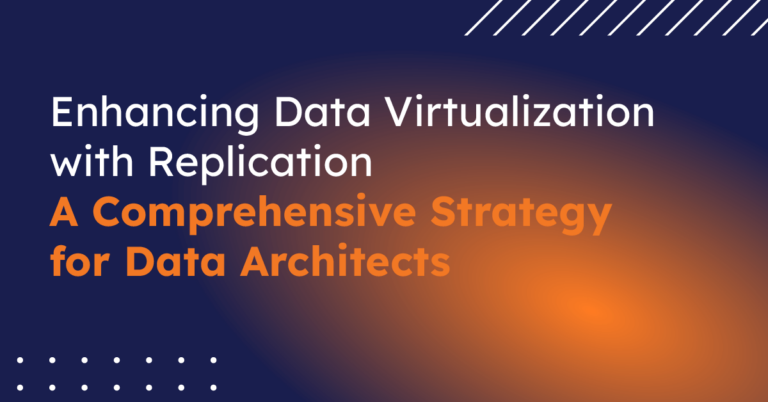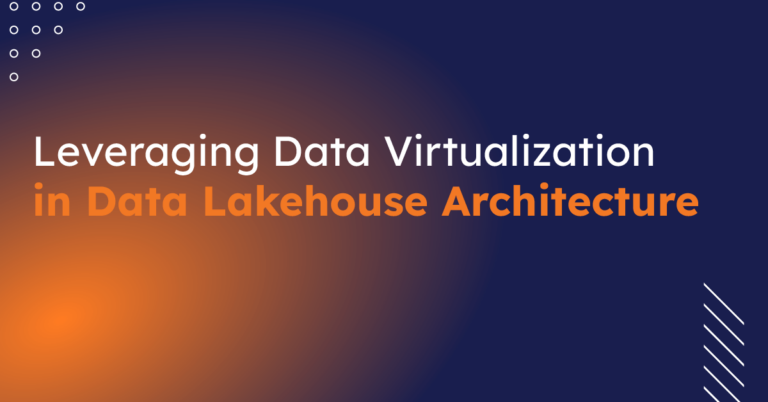
CData Software Acquires Data Virtuality to Modernize Data Virtualization for the Enterprise
Data Virtuality brings enterprise data virtualization capabilities to CData, delivering highly-performant access to live data at any scale.
Explore how you can use the Data Virtuality Platform in different scenarios.
Learn more about the Data Virtuality Platform or to make your work with Data Virtuality even more successful.
Insights on product updates, useful guides and further informative articles.
Find insightful webinars, whitepapers and ebooks in our resource library.
Stronger together. Learn more about our partner programs.
Read, watch and learn what our customers achieved with Data Virtuality.
In our documentation you will find everything to know about our products
Read the answers to frequently asked questions about Data Virtuality.
In this on-demand webinar, we look at how a modern data architecture can help data scientists to be faster and to work more efficiently.
Learn more about us as a company, our strong partner ecosystem and our career opportunities.
How we achieve data security and transparency
There’s absolutely no doubt that 2023 has been a breakthrough year for Generative Artificial Intelligence (AI). It is everywhere and is already transforming business in terms of assisting people, improving productivity, and automating tasks.
So, what is generative AI? Generative Artificial Intelligence (AI) is a subset of deep learning where multi-layer neural network models generate new content such as text, images, audio, video, code, and synthetic data in response to natural language prompts based on what the models have learned from patterns in the content they were trained on. Examples of these generative AI models are large language models, the most well-known of which is probably Open AI’s GPT4 which has been popularised by the emergence of the Open AI ChatGPT service. Others also exist such as Google’s PaLM model. These Generative AI models are sometimes called ‘foundation models”. Their foundation is that they are trained on vast amounts of public content on the internet.
The benefits of generative AI are significant. One of the main benefits is improvements in productivity to get work done faster. For example, AI-powered conversational search, text generation, code generation, assisted metadata curation, and AI-automated actions all help to get things done quicker in response to natural language prompts.
It is not surprising therefore, to see prompt-based natural language user interfaces now emerging everywhere in tools and applications to make them much easier to use. This broadens the use of tools within the enterprise by opening them up to lesser skilled business users who previously may have found the user interfaces of those tools too difficult to use. With natural language, more people can get involved which is especially important when there is a shortage of highly skilled professionals to meet business demand. It also enables work to be delegated to AI ‘assistants’ to generate content or code and to act on the users’ behalf. This applies whether it is to do with business tasks, data management tasks or explaining business insights and their business impact to drive value-added actions in everyday business.
As you would expect, generative AI is already emerging in almost every area of data management as shown in the figure below.

This includes data engineering, data virtualization, data catalogs, business glossaries, data marketplaces, data governance and more. The introduction of generative AI in data management software tools make the following possible:
One area where there is a shortage of highly skilled people is in data integration and growth in demand for AI is set to cause an even bigger shortage in this area because AI needs data and data engineering. Most companies already have a bottleneck here because of a shortage of trained professional IT data engineers. It is often the case that central IT data engineering teams can no longer keep pace with demand for more data from business users who want to add to what they already know. Companies therefore need to get more non-technical people involved in data integration across the business to deal with this bottleneck. There is clear evidence emerging to confirm that the demand for data integration is set to become more acute. A survey by Pluralsight showed that Artificial intelligence and machine learning skills are the most in-demand cloud skills (23%) in 2023, up 16% on last year but that the largest cloud skills gaps exist in data, analytics, engineering (42%). The problem here is that AI adoption is slowed down by the lack of data engineering skills. Also Randstad, the largest talent company in the world, recently posted their Work Monitor Survey that shows their own AI postings have increased by 2,000% since March 2023! A recent article in Computerworld also shows a surge in AI skills job postings. Given this demand, citizen data engineers are needed to fill an already increasing gap in data integration skills.
In addition, even in professional circles, data integration has always been one of the most time-consuming tasks since the birth of the data warehouse over thirty years ago. Therefore, improvements in productivity are needed and people are looking at generative AI as a way to help enable that, especially among non-technical ‘citizen’ data engineers.
With so many data sources available, it is inevitable that almost every data scientist and non-technical business user will need to integrate data at some point. However, skill sets vary among non-technical people. Therefore, they need assistance to ensure what they are creating will correctly integrate the data they need and will run in a performant manner. This assistance comes in the form of generative AI like ChatGPT which can be used to help people:
This is true whether you are integrating data to build virtual or physical data products, machine learning models, or any analytical data store such as a data warehouse or a data mart.
These are users of generative AI when producing data but with the emergence of data products and data mesh, generative AI is also important on the data consumption side. For example, non-technical business user data consumers may want natural language explanations of data in one or more data products or an explanation of the complex query transformations that produced these data products. They also want assistance to help them quickly produce their own queries if they need to integrate that data to create new virtual views and produce insights in BI tools. In this case AI-generated natural language descriptions of physical and virtual data products together with AI-generated natural language explanations of queries makes a huge difference in improving the efficiency of non-technical users and their ability to develop error free, optimised queries.

Generative AI is an exciting new technology which is helping to democratise and accelerate data management tasks including data engineering. It helps to lower the skills bar, broaden inclusion, accelerate development, make complex code in data pipelines understandable, accelerate metadata creation and data governance. It also helps explain business insights and the business impact while shortening the time to value and the time to act.
Furthermore, tool vendors will likely implement this together with reinforcement learning so that ultimately everyone will get a self-learning AI-Assistant.
To this end, we are excited to announce the beta release of our SQL AI Assistant powered by ChatGPT, integrated into our SaaS solution. We encourage you to test it and provide your feedback and ideas. Start your free 30-day trial and enable it in Preferences.
In the world of generative AI and data management, there’s a whole world of possibilities waiting to be uncovered. While AI is all the buzz these days, putting it to work in organizations is still a work in progress. To help you bridge the gap and get a handle on AI’s true power, we invite you to check out our one-hour webinar recording with Mike Ferguson and Nick Golovin. We’ll go deep into the practical use cases of AI and show you how it can transform your business

About the author
Mike Ferguson, an accomplished independent analyst, and thought leader excels in Business Analytics, ML, Big Data, Data Management, and Intelligent Business. Recognized for his expertise in integrating BI/ML/AI to achieve real-time business optimization. As chairman of Big Data LDN and a member of EDM Council CDMC Executive Advisory Board, he’s a prominent figure in the industry.

Data Virtuality brings enterprise data virtualization capabilities to CData, delivering highly-performant access to live data at any scale.

Discover how integrating data warehouse automation with data virtualization can lead to better managed and optimized data workflows.

Discover how our ChatGPT powered SQL AI Assistant can help Data Virtuality users boost their performance when working with data.

While caching offers certain advantages, it’s not a one-size-fits-all solution. To comprehensively meet business requirements, combining data virtualization with replication is key.

Explore the potential of Data Virtuality’s connector for Databricks, enhancing your data lakehouse experience with flexible integration.

Learn about the three-level performance optimization mechanism in the Data Virtuality Platform and how it can help you achieve maximum efficiency.
Leipzig
Katharinenstrasse 15 | 04109 | Germany
Munich
Trimburgstraße 2 | 81249 | Germany
San Francisco
2261 Market Street #4788 | CA 94114 | USA
Follow Us on Social Media
Our mission is to enable businesses to leverage the full potential of their data by providing a single source of truth platform to connect and manage all data.